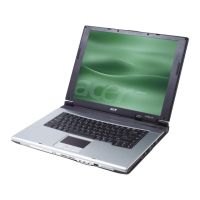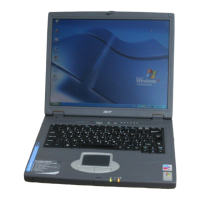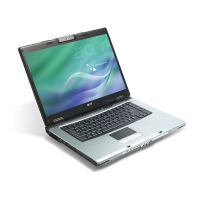
Do you have a question about the Acer TravelMate 2310 and is the answer not in the manual?
| Chipset | Intel 852GM |
|---|---|
| Storage | 40 GB HDD |
| Maximum Resolution | 1024 x 768 |
| Graphics | Intel Extreme Graphics 2 |
| Card Reader | No |
| Processor | Intel Celeron M / Intel Pentium M |
| RAM | 256 MB DDR SDRAM |
| Display | 15.0 inches |
| Optical Drive | DVD/CD-RW combo |
| Audio | Stereo speakers, microphone |
| Networking | 10/100 Ethernet |
| Wireless | 802.11b/g |
| Ports | 3 x USB 2.0, VGA, Microphone, Headphone |
| Battery | 6-cell Li-Ion |
| Operating System | Windows XP Professional |
Highlights the main features of the computer, covering platform, memory, storage, display, communication, and audio.
Lists and describes the computer's input/output ports, including USB, Ethernet, and audio jacks.
Diagram showing component locations on the motherboard's top side.
Diagram showing component locations on the motherboard's bottom side.
Details and descriptions of front-facing computer components and indicators.
Visual guide to ports and indicators on the closed front of the laptop.
Diagram and labels for the left side view of the laptop.
Details of ports and features visible on the right side of the laptop.
Illustrates ports and features located on the back of the laptop.
Explains the components and connectors found on the underside of the laptop.
Explains the functionality of Caps Lock, Num Lock, Scroll Lock, and the embedded keypad.
Describes the function of Windows-specific keys for system shortcuts.
Details the function of the Windows logo key and the Application key.
Explains how to use Fn key combinations for system controls and shortcuts.
Lists specific hotkey combinations for system management like volume and brightness.
Instructions on typing special characters like the Euro symbol.
Explains how to use the touchpad for cursor movement, selection, and scrolling.
Details on system board chipset, processor, BIOS, cache, and memory specifications.
Specifications for hard disk drives, floppy drives, and combo/DVD-RW drives.
Details on LAN, Modem, Wireless modules, and communication interfaces.
Information on video interface, resolutions, and LCD panel specifications.
Details on USB ports, PCMCIA slots, and keyboard/battery/LCD specifications.
Specifications for AC adapter, power management, and environmental operating conditions.
Provides dimensions, weight, I/O ports, material, and indicator details.
Guide to accessing and navigating the BIOS Setup Utility, including info, main, security, and boot screens.
Details on BIOS security, boot order, exit options, and flash utility procedures.
Lists required tools and preparatory steps before disassembling the notebook.
Step-by-step instructions for removing major components like battery, HDD, CPU, LCD, and modules.
General troubleshooting steps, system checks, and error message interpretation.
Covers memory, power, POST errors, BIOS beep codes, and symptom-to-FRU mapping.
Guidance for intermittent, undetermined problems, and FRU isolation.
Diagrams and lists for locating jumpers and connectors on the motherboard's top view.
Diagrams for locating jumpers and connectors on the motherboard's bottom view.
Exploded diagram and list of FRUs for major components like adapters, batteries, boards, and cables.
Lists FRUs for chassis parts, HDD, optical drives, CPUs, LCD modules, and speakers.
Lists FRUs for heatsinks, miscellaneous items, and all types of screws.
Lists compatible processors, memory, storage, I/O, and network devices tested under Windows XP.












